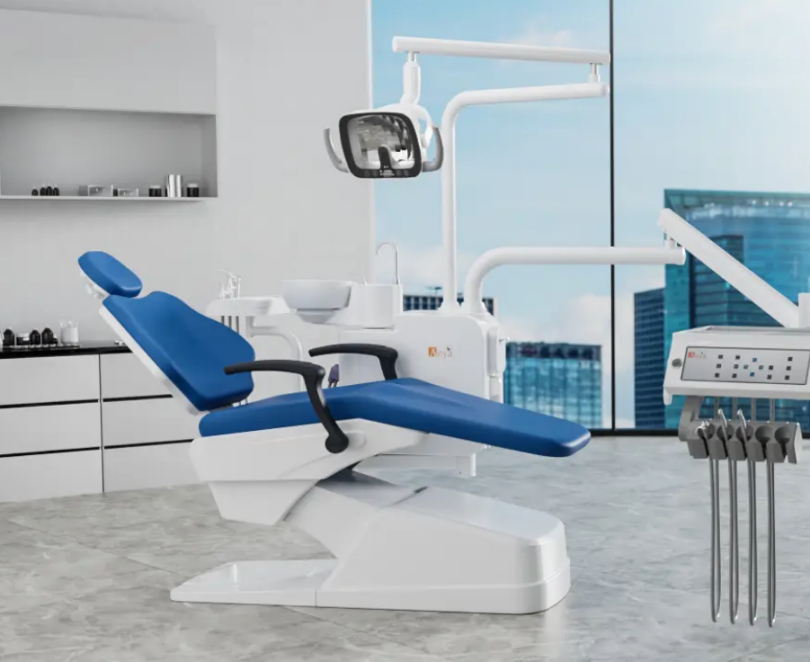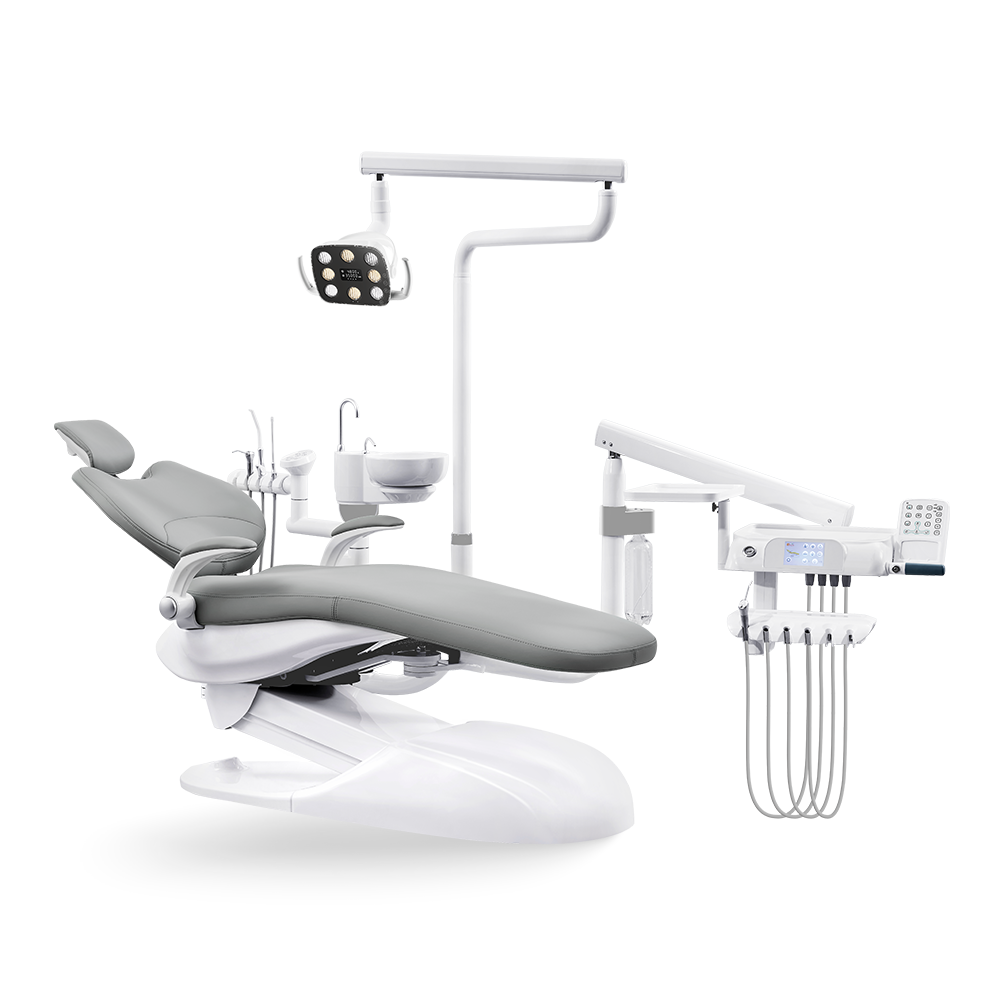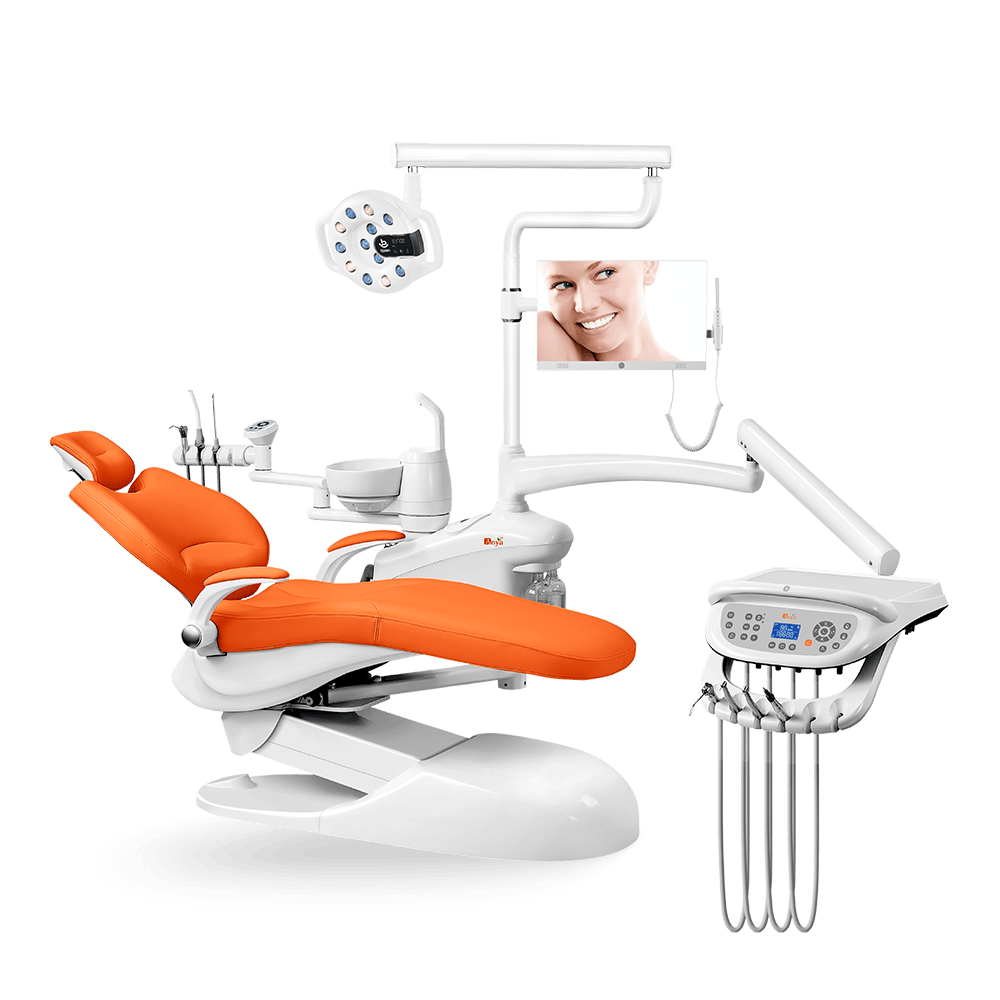The modern dental practice increasingly prioritizes environmental responsibility alongside clinical excellence. Today’s sustainable dental chairs combine resource-efficient technologies and eco-conscious materials to reduce environmental impact while maintaining superior patient care. This comprehensive guide examines evidence-based innovations helping dental clinics achieve sustainability goals while meeting stringent 2025 EU Medical Device Regulation standards.
Energy-Efficient Dental Chair Systems
Advanced energy management represents the foundation of sustainable dental chair design. Modern innovations have significantly reduced power consumption while enhancing clinical performance.

Comparative Efficiency Systems
| Feature | Traditional Models (2023) | Eco-Friendly Models (2025) | Impact |
|---|---|---|---|
| Energy Recovery Rate | 12-18% | 25-30% | +67% efficiency |
| Standby Power Draw | 8-12W | 3-5W | -60% consumption |
| Operational Lifespan | 8-10 years | 12-15 years | +50% longevity |
The latest generation of dental chairs employs dual-phase power management systems that intelligently adjust consumption based on usage patterns. These systems can identify idle periods and automatically enter ultra-low power states without compromising rapid availability when needed.
“Dental practices implementing energy-efficient chairs report average utility savings of $1,240 annually per operatory,” notes the Journal of Sustainable Dentistry, highlighting the economic benefits alongside environmental advantages.
Hydraulic vs. Electric Positioning Technology
Electric positioning systems have made significant advances in sustainability:
- Brushless DC motors reduce energy consumption by 28% compared to traditional motors
- Regenerative braking technology captures kinetic energy during chair movements
- Microprocessor-controlled acceleration optimizes power usage during position changes
The AY-A6000 series exemplifies this approach with its precision-control system that maintains positional accuracy while consuming 40% less energy than conventional hydraulic systems.
Sustainable Materials Revolution
Material selection dramatically impacts both environmental footprint and clinical performance. Today’s sustainable dental chairs incorporate scientifically validated materials that deliver exceptional durability while minimizing environmental impact.
Advanced Material Technologies
- Recycled Metal Frameworks
- ISO 9001-certified manufacturing processes
- 35-45% post-industrial recycled content
- Structural integrity testing exceeding 15,000 cycles
- Bio-Based Upholstery Options
- PVC-free materials reducing VOC emissions by 87%
- ANSI/ADA Specification No. 161 compliant antimicrobial properties
- Enhanced stain resistance without PFAS compounds
- Modular Component Design
- 93% of components individually replaceable
- Reduces landfill impact through targeted maintenance
- Extends functional lifespan by approximately 4.2 years
“The shift toward sustainable materials has created a dual benefit: reduced environmental impact and improved infection control properties,” according to research published in the International Journal of Dental Materials.
Water Conservation Integration
Water management represents a critical sustainability consideration for dental practices. Contemporary dental chairs incorporate sophisticated water optimization systems that dramatically reduce consumption without compromising clinical efficacy.

Quantifiable Water Efficiency
- Dual bottle systems reduce consumption by 38-42% compared to single-tank models
- Precision flow regulators deliver consistent 0.5L/minute (vs. conventional 1.2L)
- Smart flush technology uses AI-based timing to minimize water waste
These innovations translate to substantial real-world savings. A typical four-operatory practice can save approximately 98,000 liters of water annually by implementing current-generation water conservation systems, according to the Dental Sustainability Alliance.
The AY-A4800 Implant Series demonstrates this approach with its integrated water monitoring system that provides real-time efficiency data to practitioners, enabling evidence-based conservation decisions.
Regulatory Compliance Framework
Sustainable dental equipment must navigate complex regulatory requirements. Understanding these frameworks is essential for making informed procurement decisions.
2025 Certification Landscape
| Regulatory Standard | Focus Area | Documentation Requirements |
|---|---|---|
| ISO 13485:2023 | Quality Management | Process validation reports |
| ISO 14001:2024 | Environmental Management | Life cycle assessments |
| EU MDR Article 120 | Sustainability Claims | Material declaration documentation |
| FDA Green Program | Resource Efficiency | Energy and water consumption data |
“Compliance with 2025 standards requires manufacturer transparency regarding material sourcing, manufacturing processes, and end-of-life considerations,” explains the Strategic Dental Chair Procurement Guide.
Maintenance Optimization for Longevity
Proper maintenance significantly extends equipment lifespan, enhancing sustainability through reduced replacement frequency. Modern dental chairs incorporate predictive maintenance systems that optimize performance while minimizing resource consumption.
Evidence-Based Maintenance Protocols
- Condition-Based Scheduling
- Sensor-driven maintenance alerts replace calendar-based intervals
- Reduces unnecessary part replacements by 34%
- Extends overall system reliability by 2.4 years
- Remote Diagnostics
- Cloud-connected monitoring identifies issues before failure
- Reduces technician travel by 52% (carbon footprint reduction)
- Enables targeted component replacement instead of system overhauls
- Self-Healing Systems
- Automated pressure recalibration extends seal lifespans
- Self-adjusting tension mechanisms reduce wear patterns
- Adaptive lubrication systems optimize mechanical efficiency
“Implementing modern maintenance protocols can extend dental chair operational life by up to 40%,” according to the Journal of Dental Equipment Engineering.
Implementation Case Studies
Real-world implementation provides valuable insights into practical sustainability benefits. These case studies demonstrate measurable outcomes from sustainable dental chair adoption.
Multi-Practice Dental Group (California)
| Metric | Before Implementation | After Implementation | Change |
|---|---|---|---|
| Energy Cost | $12,600/year | $8,840/year | -30% |
| Water Usage | 486,000L/year | 178,000L/year | -63% |
| Maintenance Events | 18/year | 7/year | -61% |
| Patient Satisfaction | 4.2/5 | 4.7/5 | +12% |
This practice implemented the AY-A8000 series with comprehensive water and energy management systems, achieving ROI within 28 months while significantly enhancing patient experience through improved comfort and reduced noise.
University Dental Clinic (European Union)
This teaching facility implemented infection-resistant dental chairs with sustainable materials, documenting:
- 42% reduction in sterilization chemical usage
- 37% lower electricity consumption
- 58% fewer component replacements over 36 months
- 94% positive feedback from clinical instructors regarding teaching functionality
Practical Implementation Guidelines
Transitioning to sustainable dental chairs requires thoughtful planning and strategic implementation. These evidence-based recommendations help practices maximize both environmental and economic benefits.

For Established Practices
- Conduct Sustainability Audit
- Baseline current resource consumption
- Identify highest-impact improvement areas
- Quantify potential ROI for replacement scenarios
- Develop Phased Implementation
- Prioritize chairs in highest-use operatories
- Consider modular upgrade options for existing equipment
- Integrate with practice-wide sustainability initiatives
- Staff Education & Engagement
- Provide technical training on efficiency features
- Implement conservation protocols and monitoring
- Celebrate measurable sustainability achievements

For New Practices & Renovations
- Integrated Sustainability Planning
- Design infrastructure to support efficient equipment
- Incorporate water conservation systems at building level
- Plan electrical capacity for renewable energy integration
- Total Cost of Ownership Analysis
- Calculate lifetime operational savings
- Factor maintenance reduction into procurement decisions
- Consider certified refurbished options for secondary operatories
Conclusion: The Future of Sustainable Dental Practices
The evolution of eco-friendly dental chairs represents a significant advancement in healthcare sustainability. By integrating evidence-based technologies with thoughtful implementation strategies, dental practices can significantly reduce their environmental footprint while enhancing operational efficiency and patient care quality.
For practices considering sustainability upgrades, a methodical approach focused on measurable outcomes provides the most direct path to success. Begin with a comprehensive assessment of current resource usage, identify high-impact improvement opportunities, and develop an implementation timeline aligned with both environmental goals and business objectives.
Resources like the CAD to Production Guide and ISO 15225 Compliance Documentation provide valuable frameworks for evaluating sustainable dental equipment options based on objective criteria rather than marketing claims alone.
As regulatory requirements continue to evolve and patient awareness of environmental issues grows, sustainable dental chair technology will increasingly become not merely an ethical choice but a business necessity. Practices that proactively embrace these innovations position themselves for long-term success in an environmentally conscious healthcare landscape.




